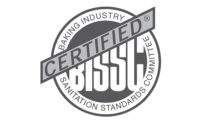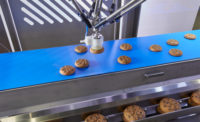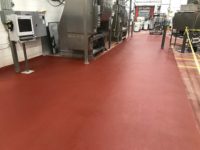To address ever-present and continuously growing sanitation-related concerns across the snack and bakery industry, equipment manufacturers are working to provide machinery that’s easy to wipe down, doesn’t provide harborage for moisture or stray ingredients, and is simple—ideally tool-less—to disassemble and reassemble as needed.
An ongoing process
To convince people of the importance of sanitation, it’s vital to emphasize the financial benefits, says Karl Thorson, global food safety and sanitation manager, General Mills, Minneapolis, and a member of BEMA’s Baking Industry Forum (BIF).
“Unless you have a crisis, a major recall, it’s hard to get people to rally around and invest in those types of changes,” says Thorson. “It’s about trying to educate people internally and externally in looking at the benefits of focusing on design, in terms of cost savings—trying to significantly reduce the changeover time, as well as labor and resources that are needed for cleaning.”
General Mills works with equipment manufacturers to encourage machinery that’s easy to disassemble and reassemble, Thorson says. “We’re trying to get them to partner with us in minimizing the complexity of design—the number of parts, the amount of surface area—and then working with us in determining what type of cleaning process we’re going to apply.” Cleaning for flavor changes requires different methodology from allergen-related issues, for example.
Thorson notes that he definitely tries to stay away from water. And if that’s not possible, you need to build the facility around that, and invest in walls, floors, drains, hot water, etc., he says.
Snack and bakery facilities sometimes require significant engineering and redesign to adequately address sanitation issues, Thorson says. “If we give them clear expectations, and they have the right skillsets in their design engineers, that’s critically important to understand the basics. We have to think more broadly than just: on time, under budget. We’ve got to think about total lifecycle costs. What is it going to cost my business in the long term?”
Snack and bakery facilities want equipment made of durable, cleanable material that does not contain gaps which can harbor microbial materials, says Bonnie Biegel, director of QA, Americas, member, Baking Industry Sanitation Standards Committee (BISSC), AIB International, Manhattan, KS. The equipment should also provides easy access for efficient, effective cleaning without compromising safety, she notes.
“You’re seeing a lot more use of stainless steel and less use of mild steel and paint, which can rust and peel,” says Biegel. “You’re seeing a lot more non-painted stainless structures and plastics that don’t require additional coating and don’t rust. They need to be sure about sealing holes, to make sure you don’t get water or product buildup inside tubular framework, where you can’t clean and access them.”
Operations and maintenance teams need to collaborate to ensure the equipment is installed in such a way that it’s relatively easy to clean, Biegel says. “They need to see where it’s placed in the bakery to make sure there’s suitable access. It doesn’t do much good to put doors on the equipment too close to the wall.”
Enhancements and challenges
The top challenge facing Douglas Machines Corp., Clearwater, FL, which provides machines that wash and sanitize bakery equipment, is the limited space of older bakery facilities, says John Schlapinski, senior design manager.
“Anything built before the year 2000, they have an area designated for washing that’s probably 12-foot square, maybe 15-foot, and then they want to do between 500 and 1,000 pans an hour,” says Schlapinsk. “We’ve tried to eliminate flat surfaces, sloped rooves, and provide ease of disassembly and reassembly so you can break the equipment down faster.”
Food safety is probably the area where Douglas Machines can help snack and bakery facilities the most, says Kevin Quinn, sales manager. The company works to provide tool-less design and access panel doors that allow maintenance workers to get inside the machine. He notes that the company has worked to create open access into the machine without having any unneeded restrictions for the operator and sanitation worker.
Great Western Manufacturing, Leavenworth, KS, which makes sifters for grains and other ingredients, has been enhancing its machines’ sanitary design with stainless steel that has fewer weldments where material can build up, as well as snap-on gaskets that eliminate the need for adhesives and sieve screen trays that eliminate staples, says Katrina Cirusse, marketing coordinator.
“The motion of the sifter can be another factor in sanitation,” says Cirusse. “Vibratory machines can sometimes upturn longer pieces of foreign matter or break an object into smaller pieces, allowing them to slip through the screens and contaminate the final product. The gyratory motion of our machines moves material over more screen area in a gentle manner, allowing only truly clean product to pass through our screen.”
Recent offerings from Great Western have included the Quality Assurance Gravity Flow Sifters and QA In-Line Sifters, both made of stainless steel and designed with fewer parts and pieces than previous models, eliminating cracks and crevices, Cirusse says. “The In-Line is also a versatile sifter that can be used in several places within the process.”
Alex Kanaris, president Van der Graaf, Brampton, Ontario, says his company designs motors to the standards of the meat and poultry industries, which makes them perfectly applicable to snack foods and other food applications. “We have been designing our products strictly for sanitation, working within USDA regulations,” he says, noting that in processing facilities that do meat, the ground zero for bacteria sanitation is on the belts and drives. “We said, ‘OK, look at what is acceptable today.’ It’s not really sanitary, especially for meat and poultry. You have a lot of byproduct accumulation in those areas.”
To solve that dilemma, Van der Graaf designed the SSV Sanitary Drum Motor in such a way that sprockets are unnecessary, and the motor and gearbox can be placed inside the frame of the machine, Kanaris says. “By not using sprockets, we avoid a couple of things. There’s no foreign material contamination, because there’s nothing to break, and there’s better sanitation, because there are no crevices or anything that can promote bacteria buildup.”
Another benefit of the design is for applications that need to be washed down or sanitized, the time involved is cut by about two-thirds, notes Kanaris. “It addresses sanitation, efficiency and safety. Those are the three legs in our stool.”





